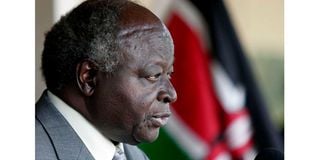Premium
Why ‘Kibakinomics’ worked

In this file photo taken on January 03, 2008 Kenyan President Mwai Kibaki reads a statement to members of the press in Nairobi.
What you need to know:
- Students of economic history continue to ask, what brand of economics did Kibaki believe in and practise?
- How did his administration manage to consistently deliver dramatic growth?
With the death of retired President Mwai Kibaki, Kenya has lost one of its most brilliant economists and remarkable public servants. Students of economic history continue to ask, what brand of economics did Kibaki believe in and practise? How did his administration manage to consistently deliver dramatic growth, especially in the early years of his tenure in State House?
In theory, you can brand Kibaki as a Keynesian economist. John Maynard Keynes was the 20th-Century British economist whose ideas fundamentally changed the theory and practice of macroeconomics. His policies embodied the conventional notion that modern capitalism needed high levels of spending and rock-bottom interest rates to thrive.
A consummate nationalist, Kibaki’s approach to economic policymaking when he became President in 2002 was greatly influenced by the nationalistic thinking that dominated mindsets of our leaders in the immediate post-Independence period.
Those were the days when a shopkeeper could not just raise the price of unga without the approval of the Price Controller. A company could not just declare workers redundant without consulting the Commissioner of Labour. A trader could not import finished goods without first seeking a ‘no objection certificate’ from a local manufacturer of the same product.
Those were the days of the ‘Africanisation’ policy, when we had a whole government department — the Kenyanisation of Personnel Bureau—responsible for forcing multinationals to appoint Kenyans to understudy every expatriate manager.
Kibaki was, perhaps, the most influential architect and intellectual force behind the design of the command and control regime. Then, entities like the Industrial and Commercial Development Corporation, Development Finance Company of Kenya, Industrial Development Bank, Kenya Industrial Estates and Agricultural Finance Corporation were strong and robust.
Today, we deride that regime as practising unworkable economics, having swallowed the policies of the Washington Consensus. The big difference between the early years of Independence and today is that Kibaki and his peers were firmly in the driving seat of economic policy.
Being in charge of your destiny matters, and that is exactly what President Kibaki decided to do. The economy had suffered decades of underfunding on infrastructure. He followed the Keynesian rule book: Borrow domestically, spend massively on infrastructure and keep interest rates low. In the Financial Year 2005/2006, the gross development budget for roads was a mere Sh17 billion. The following year, it was jerked up by over 85 per cent to Sh32.7 billion.
Kibaki spent massively on free primary education and reviving struggling commodity marketing boards—like Kenya Co-operative Creameries, Kenya Meat Commission and Pyrethrum Board of Kenya — and wrote off huge loans owed to sugar companies. He spent massively in increasing the salaries of teachers, judges and MPs and allocations to the Constituency Development Fund (CDF).
That was on the fiscal policy side. How did he bring interest rates down? By disrupting the dynamics in money markets. In his budget speech of 2003/2004, Finance Minister David Mwiraria reduced the cash reserve ratio from 10 to six per cent. Banks suddenly found themselves with massive excess reserves, forcing them to start hawking personal loans to wananchi.
Read: Statesman Mwai Kibaki
Interest rates on the 91-day Treasury Bill tumbled from eight per cent in December 2002 to below two per cent in late 2003 and the first half of 2004. The interbank market — where banks lend to one another — was also heavily disrupted with rates falling from around six per cent in early April 2003 to 0.4 per cent in mid July. Such was the disruption that the IMF hurriedly dispatched a mission led by Dr Godfrey Kalinga, a Tanzanian, to Nairobi to warn us about an impending collapse of the bond market and advise the government to allow interest rates to start gliding upwards.
But if massive borrowing and infrastructure spending produced magic growth numbers for Kibaki, why didn’t they work for President Uhuru Kenyatta and DP William Ruto? It is because, under Jubilee, financing of infrastructure spending was dominated by the Chinese and vulture commercial lenders from Europe.
Former Governor of the Bank of Tanzania Bennon Ndulu (deceased) argued the point lucidly in a paper presented at a seminar in memory of another Kenyan economic giant, Prof Francis Mwega. Since most of the Chinese loans are disbursed at source and come in kind — most of the imported materials for Chinese-funded projects are exempt from duty and tax — that spending is not liquidity financing and ends up causing big leakages in multiplier effects. As a country absorbs more of the Chinese Exim Bank-type loans, the leakages become more pronounced.
Under Kibaki, infrastructure spending resulted in an unprecedented increase in revenue collection, low interest rates and spectacular GDP growth. Under Jubilee, it gave us the Arror and Kimwarer dams scandals and an unprecedented number of corruption cases in the energy sector.





